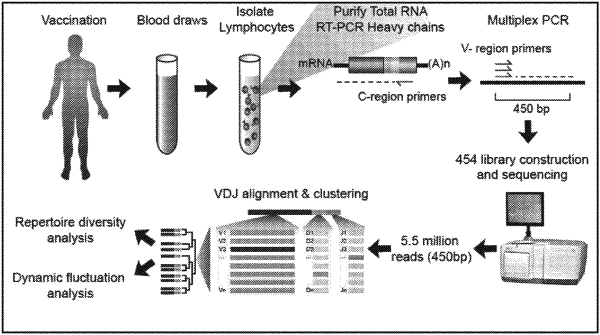| CPC C40B 10/00 (2013.01) [C07K 16/00 (2013.01); C12N 15/10 (2013.01); C12Q 1/6806 (2013.01); C12Q 1/6881 (2013.01); C40B 30/04 (2013.01); C40B 40/08 (2013.01); G16B 20/00 (2019.02); G16B 30/00 (2019.02); C07K 16/065 (2013.01); C12Q 1/6874 (2013.01); C12Q 1/6883 (2013.01); C12Q 2535/00 (2013.01); C12Q 2535/122 (2013.01); C12Q 2600/112 (2013.01); C12Q 2600/158 (2013.01)] | 14 Claims |

|
1. A method comprising:
a) linking a polynucleotide sequence encoding a heavy chain variable region (VH) and a polynucleotide sequence encoding a light chain variable region (VL) from a single lymphocyte from a first biological sample from a subject, thereby forming first paired sequences; and performing high-throughput sequencing of the first paired sequences, thereby forming a first reference library of paired sequence reads,
b) linking a polynucleotide sequence encoding a heavy chain variable region (VH) and a polynucleotide sequence encoding a light chain variable region (VL) from a single lymphocyte from a second biological sample from the subject, thereby forming second paired sequences; and performing high-throughput sequencing of the second paired sequences, thereby forming a second reference library of paired sequence reads,
wherein the first biological sample is or has been obtained before an immune response of the subject and the second biological sample is or has been obtained during or after the immune response of the subject, and
c) comparing the paired sequence reads of the first reference library and the second reference library.
|